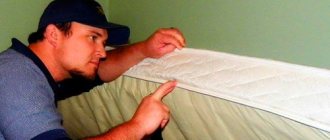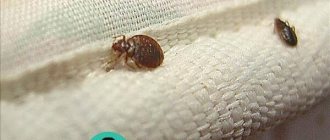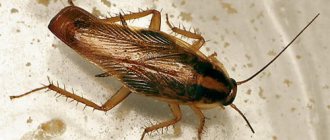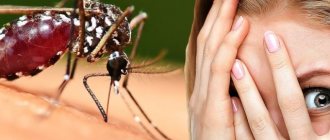How to get rid of fleas in an apartment
- 19 years of work experience Contents of the article
Fleas are ectoparasites that are often found in dormitories, change houses and in rooms with unsatisfactory sanitary conditions. They spend most of their time on the host's body, feeding on blood. Ectoparasites attack cats, dogs, farm animals, and rodents. But sometimes annoying individuals appear in the apartment, annoy the residents, cause discomfort, and interfere with peaceful rest and sleep.
In a person's home you can find earthen fleas, bed fleas, and sand fleas. Choosing one owner, they easily change it to another. That is, a flea can jump from a cat or dog to a person. These are small bugs measuring 1-5 cm that are capable of jumping long distances. Getting rid of fleas on your own is extremely difficult due to their small size and secretive lifestyle. But the main obstacle in the fight is the high resistance of parasites to negative external factors. They easily withstand changes in temperature and humidity and are capable of entering into suspended animation if necessary. Next, we’ll look at how to quickly and permanently get rid of fleas in an apartment, prevent their reappearance, and create a protective barrier.
Properties of boric acid and rules of use
Among pharmaceutical preparations, boric acid is considered an effective remedy against fleas - a fine-crystalline white powder without taste or odor. This inorganic mineral has fungicidal, insecticidal, and herbicidal properties. This low-toxic substance does not repel parasites, but kills them by causing loss of moisture in their body.
The principle of action of this drug:
- in a room that requires treatment, all objects should be removed from the floor;
- the premises should be isolated from pets;
- Carpets must be vacuumed first;
- carry out wet cleaning;
- Sprinkle boric acid evenly over the floor and spread it over the carpet using a brush;
- after 2 days, the powder and dead insects are collected with a vacuum cleaner.
It is advisable to treat skirting boards around the entire perimeter of the room and bedding for pets with the substance. In contact with acid, insects will independently spread the substance.
Preparing a flea solution.
With the help of the product, eggs and larvae of parasites quickly die. To remove adult individuals, the premises will need to be re-treated after 2 weeks. During this period, new larvae will appear, but because... If they are not yet able to reproduce, then all insects in the house will be destroyed.
To enhance the toxic effect of the acid, it is recommended to mix it in equal parts with washing powder.
You can quickly get rid of fleas in your living space using boric acid in liquid form. 2 bottles of the product (you can buy them at the pharmacy) are added to a bucket of water. After thoroughly mixing the resulting solution, wash the floors, treating all the far corners under the furniture.
The contents of another bottle are dissolved in 10 liters of water and stirred. The solution is poured into a container with a spray bottle and all surfaces of furniture and walls are thoroughly treated so that they become damp. To achieve the desired result, the procedure should be repeated up to 3 times with breaks of 1 day.
At the same time, the stairwell, basement and courtyard must be treated with more potent agents.
Where do fleas come from in an apartment?
Faced with ectoparasites, city residents become perplexed; they have a question: “Where do fleas come from in an apartment?” There are several main sources of their appearance:
- The parasites caught on the fur of a cat or dog during a walk, and then successfully multiplied in the apartment to a large population.
- One of the family members returned home from a business trip. In cabins, hostels and hotels with a low level of service, fleas are common inhabitants.
- In a private home, fleas can be brought in by rodents that live in the attic, basement, or technical buildings.
- Residents of the first floors of city high-rise buildings can become victims of earthen fleas. They inhabit basements with a constant source of heat and high humidity, and can migrate to nearby apartments.
- Fleas can move not only from the technical room, but also from a neighboring apartment if its residents decide to carry out disinfestation.
Sometimes a person brings fleas into an apartment along with furniture and other household items that had previously been stored in a warehouse for a long time. The likelihood of an event increases when purchasing used goods. Ectoparasites can also migrate into an apartment on shoes and clothes from a park or work warehouse or basement.
How to remove fleas from your home using chemicals
Before using chemicals, you need to thoroughly clean the apartment, so the fight will be more effective.
We strongly recommend that you send your household members out for a walk for a while so as not to breathe in harmful chemical vapors, and when using insecticides, use personal protective equipment - a mask, gloves, and protective clothing. Treatment with drugs should be carried out with windows and doors closed so that the substances do not evaporate. You need to treat every centimeter of cracks, baseboards, cracks, folds of furniture, and corners. Usually the substances begin to act within 3-4 hours. A few hours after treatment, the room must be thoroughly ventilated.
Means for killing fleas in the apartment are divided into groups. Let's see what fleas are afraid of in the house and how to get rid of them quickly and effectively.
Aerosols
Without a doubt, this is the most effective remedy available to the average person. They are sprayed in places where blood-sucking creatures accumulate. The active substances penetrate the flea's body, after which it dies. By using aerosols you can get rid of pests in a short period of time.
Aerosols often used are Raptor, Dichlorvos, Raid, Kombat, Doctor Claus,
Solutions
Concentrated solutions are diluted in water and the resulting preparation is sprayed on walls, baseboards, cracks and other habitats of bloodsucking creatures.
Common people advise using Get, Tsifoks, Tetrisk, Zone solutions. Cucaracha is also popular, but the downside of the drug is its strong smell.
Dusts and powders
The substance affects the nervous system of the pest, causing paralysis. The product lasts for quite a long time. But it is better to use this product to combat larvae, as they absorb organic debris and can eat poison.
The drug Delicia is popular, although it mainly destroys feline and canine species.
Where do fleas live
Disinsection involves the complete treatment of the apartment, but special attention is paid to places where flea nests are located. Finding specific habitats of small parasites is not easy. How to determine where fleas live? They prefer to build nests:
- near the ventilation grille;
- in the space under furniture;
- on the wrong side of a pet's bed;
- in mattresses and sofa folds;
- behind the baseboard;
- on the underside of the carpet.
Fleas spend most of their time on the host's body. You can verify this by examining the fur of a cat or dog in an apartment inhabited by ectoparasites.
How to use ammonia solution against insects
To treat premises with ammonia, use a solution or substance in its pure form. With such a variety of options, you can choose the most suitable method for yourself.
Ammonia in its purest form
In order to use ammonia solution in its pure form, the following methods are used:
ammonia is drawn into a syringe and sprayed in hard-to-reach places: under baseboards, between pipes, in cracks in the walls and in the floor, between the walls of furniture, and so on; Small containers filled with ammonia solution are placed throughout the home, paying special attention to those places where cockroaches appear most often; pieces of cloth soaked in ammonia are laid out in the corners of the rooms, near the trash can, under the sink pipes.
Weak and saturated ammonia solutions
The most popular way to use ammonia against insects in the home is wet cleaning using a solution prepared on the basis of this product. For this:
- Add 1 teaspoon of ammonia to a liter of cold water.
- The resulting mixture is used to wash baseboards, doorways, window sills, furniture and floors.
This method is suitable both for expelling existing cockroaches and for preventing the appearance of new ones. This treatment of the home is safe for adults, children and animals.
In cases where it is necessary to repel a large number of cockroaches, a more saturated solution is used for the initial treatment of a house or apartment: 100 ml of alcohol is diluted in a liter of cold water. For preventive purposes, such cleaning is carried out once a month. It must be remembered that ammonia does not kill insects. The effect is achieved only due to the fact that the pungent aroma forces insects to leave their favorite territory and not appear on it again (with regular cleaning using ammonia).
Ammonia and vinegar
To prepare and use a mixture of ammonia and acetic acid, perform the following steps:
- Add 200 ml of each active ingredient to a liter of water and mix all ingredients thoroughly.
- The resulting product is poured into small containers and placed in places where the greatest insect activity is observed.
Why are fleas dangerous?
An unpleasant painful bite of an ectoparasite is the cause of constant skin itching. Such sensations arise due to the fact that the flea pierces the skin, but does not secrete pain-relieving enzymes that clot the blood. She does not have a proboscis, and to gain access to a blood vessel she is forced to penetrate the layer of skin. This increases the pain and promotes the formation of a swollen area.
But discomfort is not the main thing that makes fleas dangerous. Their enzymes cause an acute allergic reaction in sensitive people in the form of fever, itching and inflammation. In addition, fleas carry pathogens of dangerous diseases: encephalitis, plague and typhus, salmonellosis, hepatitis, and fungal infections.
Ectoparasites can feed on the blood of sick and dead individuals. In the Middle Ages, fleas caused the bubonic plague, which killed millions of people. At that time, rats contributed to their spread.
Preparation of the solution
To carry out disinfection with ammonia, it is important to know how to dilute ammonia for fleas. To do this, take 5-6 drops of the drug per 0.5 liter of warm water.
The prepared solution of ammonia in the apartment can be sprayed on the floors and upholstered furniture; the product is added in combination with flea shampoo to the bath where the pet bathes.
If ammonia is diluted incorrectly, then when poisoning fleas, you can harm your household, since children and animals are more sensitive to toxic substances.
Adults should also observe safety precautions when working with camphor and ammonia, because camphor with vinegar and ammonia for fleas, if used incorrectly, can burn the mucous membranes and lead to vapor poisoning.
Effective ways to get rid of fleas
Fighting fleas is difficult due to their biological and physiological characteristics. They reproduce quickly, turning from larvae to adults in two weeks. The lifespan of one individual reaches two years. During this period, the female manages to lay several hundred eggs. If fleas are not detected at the initial stage of their appearance, the scale of the disaster will become catastrophic. It will take a lot of time and effort to destroy a large population. They cannot be attracted by food bait, like other insects, since fleas are only interested in blood.
Depending on the number of fleas in the apartment and the neglect of the situation, different control methods will help get rid of ectoparasites. In the initial stages, you can solve the problem yourself. But if the parasites have already managed to multiply, then effective ways to get rid of fleas will include an integrated approach and professional help from pest control services.
Independent options for killing fleas
The greatest effectiveness in self-extermination of fleas comes from an integrated approach, which involves the use of traditional, physical and chemical control methods. Let's take a closer look at each of the options.
Chemicals against fleas
In the store you can find insecticidal preparations in the form of aerosols, liquids, powders, gels, and granules. The release form greatly influences the effectiveness of the chemical.
The maximum result is obtained by preparations in the form of aerosols, since the working solution is sprayed into them in the form of a mixture of tiny particles and air. This allows the insecticide to penetrate into all joints, cracks and openings. Spraying is a quick and effective way to treat large areas of the apartment. Among aerosols, Raptor, Get, Dichlorvos, and Reid show good results.
When using aerosol insecticides, the apartment will need to be left for some time - several hours or days (depending on the recommendation in the instructions). At this time, there should be no animals or people in it.
Dusts - powder preparations - are actively used to combat fleas. The process of treating an apartment will be more labor-intensive and expensive, but it is suitable for pet owners. Dust must be scattered under carpets, along cracks, under baseboards. It can be left for a long time until all the fleas are killed.
How to get rid of mold on floors and walls?
If mold has formed on the floor, be sure to find out the cause of its appearance and remove the provoking factor. Otherwise, cleaning will provide a temporary effect.
- To combat fungus, use undiluted “Whiteness”. Apply it with a sponge to the affected areas of the floor and walls and wait until the composition dries.
- During this time, the black spots should lighten. Take a brush and clean the mold.
- Fill a bucket with water, add “Whiteness” at the rate of 100 ml per 1 liter and thoroughly wash the floors.
“Whiteness” has a detrimental effect on most bacteria and viruses, so it is suitable for wiping surfaces and washing floors. If you follow safety rules and adhere to the instructions, the product cannot harm - provided that there is no allergy to the composition.
Preparing the apartment for flea treatment
Before treating the apartment, you need to find out where the fleas came from. If the source is not eliminated, then some time after disinfestation the parasites will reappear in the apartment. In an apartment building, fleas often migrate from the basement. In this case, you should contact the management company for help. She should hire a professional service to exterminate the ectoparasites. If the cause of fleas is a pet, special veterinary preparations will help clear its fur of fleas.
Recommended Links
Preparing an apartment for flea treatment begins with general cleaning and processing of textiles:
- Pet beds, blankets, toys, bedding and other items must be washed at high temperatures and treated with a steam generator or iron.
- Large items that cannot or cannot be washed should be dry cleaned.
- Thoroughly vacuum the carpet, upholstered furniture, baseboards, cracks, joints and openings.
- Clean out the pantry, get rid of unnecessary junk and old clothes.
- Treat cabinet shelves and furniture surfaces with a disinfectant solution.
You should free up space as much as possible from small objects, clear out cabinets and shelves. Only after this can you begin to disinfest the premises.
Necessary measures for exterminating insects
In order for the fight against fleas in your apartment to end successfully, you need to follow simple recommendations that will significantly increase your chances of success.
- Carry out a thorough cleaning of the apartment! This is the first and main thing to do. Vacuum carpets, upholstered furniture, wash all floors. Adding ammonia or essential oil to the water for washing floors will greatly help reduce the number of colonies. After cleaning, the vacuum cleaner bag should be quickly packed in a thick plastic bag so that the bugs do not have time to jump out and thrown away.
- If you suspect that it is the bedding species that are bothering you, you need to wash all bedding at a temperature of 60 degrees or higher (the parasites are very tenacious, they can survive at lower temperatures), then iron them.
- If the infection appears in the wardrobe, the clothes must be treated independently with an iron or steam, or taken to dry cleaning.
- Carefully treat blankets, pillows, mattresses, soft toys. If this is the case in winter, then you can take things out into the cold, or, if the fight is in the summer, leave them to bask in the sun. Parasites cannot tolerate temperature changes.
- Wash all your shoes that you wear outside. As we remember, eggs and larvae can get into the house on the soles of shoes, so in order to avoid the appearance of new individuals, you need to pay attention to this point.
Flea prevention
After exterminating fleas, it is important to prevent their reappearance. To do this, it is enough to follow simple rules. Preventing your apartment from fleas involves regular inspection and proper care of pets, keeping the house clean, and using natural and artificial repellents.
If your work activity involves being in a basement or other places with a warm and humid microclimate, you must leave your work clothes in the work closet. After leaving a room where fleas may live, you should inspect yourself for the presence of ectoparasites.
Separate recommendations should be given to owners of pet four-legged friends. To help prevent fleas:
- Regular treatment of animals with special sprays and drops.
- Using a flea collar.
- Regular washing of cat and dog beds, clothes and other textile items.
- Using anti-flea shampoo.
- Inspect your pet after every walk.
- Regular combing with a special comb.
Residents of the first floors of apartment buildings are most likely to become victims of fleas. It is to them that ectoparasites often migrate from the basement through the ventilation system. A protective barrier using repellent scents and chemicals will help reduce the risk of insects. Particular attention to this issue should be paid in the summer - during the mass reproduction of ectoparasites.
Where do they come from
Insects parasitize warm-blooded animals, so they most often live either on them or in their shelters and nests. So, in summer or spring it is easy to accidentally bring them into a private house. Let's list the most common reasons for their appearance.
Reasons for appearance
- They enter rooms located on the upper or lower floors from basements and attics.
- Dogs or cats infected while walking come home with them.
- Transferred by humans along with street dust or dirt.
- High humidity and heat. These are the best living conditions for bloodsuckers.
Not all types of bloodsucking species take root at home; only about 30 species settle near people. These are mainly rat, cat, basement, human, and dog fleas. Initially they start on bedding, entrance mats, etc. Gradually spread throughout the apartment.
Where do fleas live?
- Upholstered furniture, textile toys, mattresses.
- Gaps, space under the baseboard, cracks.
- Parquet, carpet or carpet, laminate, linoleum.
- Clothes, especially where they are stored;
- Household waste.
However, eggs can be found in the most unexpected places. Females lay them not in nests, but literally everywhere. They do not require care or any special conditions to survive. Therefore, if an unpleasant neighborhood is discovered, you will have to carry out a total disinfestation, without missing a single centimeter.
How to remove fleas from your home - effective remedies and prevention
Fleas in the house cause not only unpleasant emotions, but also painful bites and the risk of contracting serious infections.
Parasites live for quite a long time, while they multiply quickly and behave aggressively. Let's look at how to get fleas out of your home quickly at home.
- Causes and favorite places of fleas
- Removing fleas from pets
- Home flea cleaning
- Store-bought products and other methods for removing fleas from indoors
- Folk remedies
- Prevention
Home Destruction Products Review
Poisoning of parasites in a living area consists of two stages: first, the animals are treated, then the insects in the rooms are destroyed. If the question arises of how to remove fleas from an apartment, you can consider a number of insecticidal products: aerosols, sprays, powders. In addition, temperature effects are used. If large premises are heavily infested, it is better to immediately call a team of exterminators.
More information about aerosols, sprays
These products spray the substance into the air. At the same time, various surfaces are irrigated: floors, furniture, walls. The smallest particles of suspended matter settle in all the cracks in the area where the treatment is carried out. Thanks to this, aerosols and sprays have gained popularity.
Popular aerosols: Raptor, Raid. Combat
There are remedies in this group that vary in degree of effectiveness:
- Professional
- For household use against domestic fleas
- Destroying flying and crawling insects: Raptor, Raid.
The last option is less toxic, so you do not need to leave the room after treatment. Using any type of spray, you need to provide access to remote corners of your home, which sometimes requires moving furniture away. Cluttered areas are cleared, as fleas usually hide here. The carpets need to be taken out. After treatment, the room is closed (doors, windows) for several hours.
Powders
When deciding how to remove fleas from the house, use bulk substances. How can you use them? It is not necessary to dilute such products with water. The powder is simply sprinkled on all possible places where fleas can live in the house.
Particular attention should be paid to baseboards, any cracks, corners
Temperature treatment of the room
This method does not require any costs. It is easy to destroy fleas at home by changing the temperature in the room. The main condition for this is to influence the temperature limits. Cold (more than -20 degrees) has a detrimental effect on parasites. For this reason, in winter, the carpet, the animal’s sleeping place, and other objects that may be infested with insects should be taken outside.
Insects can be affected by high temperatures (above +50 degrees). and low -20 degrees.
When deciding how to quickly remove fleas from your home, you can expose them to high temperatures (above +50 degrees). In domestic conditions, it is difficult to carry out such processing on your own. You will have to call specialists for this purpose, since they have the necessary equipment (heat gun). If you have a steam generator in your house, you can use it to control fleas.
Calling a pest control team
When disinfestation is called, after treatment you cannot stay in the room for 5-7 hours
This solution will provide the best result, because specialists use specialized equipment and have extensive experience in combating parasites of various types. When trying to kill fleas on your own, you may miss some areas, which will lead to the appearance of a new generation of insects and the room will again be filled with them.
Another advantage in favor of professional pest control is the possibility of using highly toxic drugs that are not always widely available. In addition, such insecticides require careful protection, which sometimes cannot be provided by a gauze bandage and closed clothing.
When calling exterminators, you need to be prepared for the fact that after 2 weeks fleas may again appear in the apartment. The reason for this phenomenon is that the offspring were hidden in deep and remote crevices that could not be reached. However, upon contact with treated surfaces, the larvae die immediately, so there is no need to call exterminators again.
Watch the video: How to get rid of fleas in an apartment yourself
Causes and favorite places of fleas
Parasites enter the house for the following reasons:
- Pets bring them after a walk;
- They stay on street clothes or boots. It's easy enough to bring insects on your soles;
- Fleas crawl from the attic or basement where the rats that carry them live.
Parasites can stay in the house for a long time. For example, the previous owners did not remove them, or there are a lot of insects in the backyard that move into the residential building.
There are many reasons why fleas appear in the house; it is important to detect them in time. If there are rats living in it, you first need to start exterminating them.
What do adult fleas and larvae look like?
Favorite places depend on the type of flea:
- Rat, dog and cat. They are found on the fur of pets or pests. After breeding and lack of food, they move first to the sleeping areas of animals, then to surrounding areas;
- Bedding. Settle on bedding sets and beds;
- Basement, earthen and plant. They are found in basements, grass and soil. When they enter the house, they remain in hard-to-reach areas with accumulation of dust and dampness. These are upholstered furniture, carpeting, cabinets with things, cracks in linoleum and parquet, toys, sink, baseboard.
Important: Not only visible areas will need to be treated. Extremely complete disinfestation of the house will be effective.
Types of fleas
Causes of parasites
The first reason that comes to mind for insects is dogs and cats. Indeed, most often it is pets who become the source of infection. But there are many other ways to bring bloodsuckers into your home.
- Basement of the house. Fleas in the basement of an apartment building both quickly appear and quickly begin to multiply. Residents of the first floors suffer from them especially.
- Shoe sole. Sometimes people themselves bring eggs of earthen species to their homes on the soles of their shoes. And they cannot always be detected immediately. Parasites are usually noticed when they have already actively begun to reproduce.
- Rent or sale of an infected apartment. Apartment owners may not completely get rid of pests before selling or renting. If you are unlucky enough to encounter such hosts, prepare for a long and persistent struggle with insects.
- Neighbours. It happens that not the most clean neighbors contribute to the spread of parasites not only in their apartment, but throughout the house.
Having discovered an infestation of blood-sucking insects, it is advisable to find out where they came from, otherwise all efforts to destroy them will be in vain.
Of course, the main reason why parasites linger in your home is the presence of favorable conditions. Lack of fresh air, uncleanliness, dirt in the house, dampness, clutter - all this contributes to their active reproduction.
Flea
Indoor fleas feed on blood, so the inhabitants of the house become an excellent source of food for them. This is the main danger, because they can carry various dangerous, sometimes even fatal diseases, as well as helminth eggs.
Pests leave painful bites. The skin at the bite sites is irritated and itchy, and the points themselves are located on the same line. Sometimes bites can cause severe allergies, especially in children.
Removing fleas from pets
To rid your pets of parasites, you will need to treat the fur with insecticides. They are not dangerous for pets, but are harmful to fleas. There are many drugs and new options are constantly appearing. The most common are the following:
- Flea drops . They are easy to use and affordable. There are a number of contraindications, but if used correctly they will not cause harm. They choose the following: “Hartz”, “Rolf Club”, “Frontline”, “Advantage”, “Stronghold”;
Flea drops
- Shampoos . This option is suitable for animals that are walked several times a day. The effect lasts for weeks or months. Existing fleas are killed in one procedure. The following popular brands are: “Mr. Bruno”, “Bifar”, “Leonardo”, “Delix”, “Doctor Zoo”;
Popular shampoos for preventing fleas in animals
- Anti-flea collars . Their action is considered more reliable, since they protect the pet from fleas the entire time the collar is on. The following are common: “Kitlix”, “Hartz”, “Beaphar”;
Flea collars
- Insecticidal sprays . Parasites are eliminated in one application, but there are a number of contraindications. They are chosen when treating a pet in conjunction with removing insects from the house. “Bars”, “Hartz”, “Advantage”, “Frontline” are considered effective.
Sprays for the prevention of fleas and ticks
Injections, tablets and folk remedies are also used to remove parasites from the fur of cats and dogs. The drug is chosen after consulting a doctor.
Methods for removing fleas from your home
You can remove domestic fleas from your home using a variety of means, each of which has its own advantages and disadvantages.
Traditional methods of fighting parasites are the most acceptable and safe. Among their advantages are the following:
- no toxic effects on humans and animals. Salt, soda and other folk remedies are safe for health. The only point that needs to be taken into account: the herbs and aromatic oils used for processing may cause allergic reactions;
- accessibility: most of the tools used are available in each apartment;
- low cost.
The disadvantages of such funds include:
- the need for repeated use;
- processing complexity.
Chemical drugs are more effective, but less safe. Before using them, you need to take care of the health of your household, the safety of vegetation, as well as the safety of the pets present in the house.
Following a number of rules will help you achieve the desired effect:
- the selected product is used to treat not only all surfaces in the apartment, but also the cracks between baseboards, cavities in furniture, kitchen sinks, the space under the bathroom and behind the washing machine;
- if animals live in the apartment, then their sleeping places also need to be treated for fleas, and the pets themselves, if possible, should be washed with a special shampoo;
- It is advisable to carry out the treatment in neighboring apartments. The fact is that insects can enter your home from neighboring rooms, so poisoning them only on your own territory may be ineffective.
The use of any means that can remove fleas from an apartment also involves carrying out a number of the following activities:
- Cleaning the room with a vacuum cleaner. This is necessary not only to remove the remnants of the poison, but also to eliminate insect eggs, on which no drug has any effect;
- Thorough ventilation. To ensure that there are no particles of toxic substances left in the air, it is necessary to ventilate the rooms well;
- Wet cleaning. After the apartment has been ventilated, you can begin to wash the treated surfaces using disinfectants.
Home flea cleaning
General cleaning of all premises will be required, so it is worth setting aside a whole day for this. Let's consider if there are fleas at home, what to do first and how to get them out:
- Wash . It is worth taking bed linen, blankets, pillows, animal items, and soft toys to the dry cleaner. This will also help detect bedbugs that are visible on furniture and mattresses. Washing should be done at a temperature of at least 50 degrees. Parasites are quite tenacious, so you can increase the temperature;
- Cleaning furniture and carpets . Most often, parasites bite your legs. This is because they are found on furniture and carpets. Therefore, it is necessary to keep them clean. It is especially important to clean carpets that are located in front of the door. You should run a vacuum cleaner over the shower mat. Vacuum cleaner waste should be placed in a sealed plastic bag, otherwise insects will be able to return to the house;
- Washing floors . In any case, it should be regular. Parasites breed everywhere, so treating floors is very important. You need to pay attention to corners, areas under furniture and cabinets, baseboards;
- Washing outdoor boots . Eggs may remain on the sole. It is necessary to wash all shoes that the owners have recently worn. This will help prevent future infection;
- Throwing things away . If there is a lot of dirt, eggs and dead fleas on the mattress, then it is better to throw it away. There is no point in fighting all this. You can turn to specialists, but it’s better to handle it yourself. With the money saved you can buy a new mattress.
Important: It is necessary to start fighting fleas after removing them from the animal’s fur.
Professional insect repellents, including fleas
How to quickly get rid of earthen fleas in a private house
Adult fleas lay eggs (up to 50 a day) in animal fur, but the eggs soon fall off and end up in carpeting, upholstery and wherever the animal runs, lies, sleeps or plays. To get rid of ground fleas, these areas require priority attention when carrying out disinfestation. If they are ignored, then 90% of the population - eggs, larvae and pupae - will remain unharmed, and the infection will resume.
In the accumulating house dust and dirt, flea larvae find shelter and food, so the fight against parasites begins with bringing order and cleanliness to the house.
- Get rid of clutter. Rooms cluttered with furniture, boxes, old equipment, toys and other things will not be processed efficiently. If you have long wanted to throw away everything unnecessary, now is the right moment for this.
- Make sure there are no rats or mice in the house. If necessary, place baits and take care that they are not accidentally eaten by pets.
- Wash your pet's bedding, covers from beds, sofas and chairs, stuffed animals, curtains, bedding and blankets. Set the washing mode to at least 50 degrees, use hot drying if possible.
- Vacuum carpets and upholstered furniture thoroughly. 80% of flea larvae in the house develop in carpets, where the pupal stage also occurs. The vacuum cleaner collects eggs, larvae and feces of adult fleas from carpets, which they feed on. The vacuum cleaner also disrupts the development process of the pupa, causing premature exit from the cocoon and depriving it of protection.
- Wash the floors in all rooms, including the bathroom and toilet, adding 10-20 drops of essential oil or other folk remedies for fleas in a private home. How to wash the floor to get rid of fleas:
- Wormwood oil
- Lavender oil
- Eucalyptus oil
- Peppermint oil
- Chamomile
- Hellebore water
- Apple vinegar
- Bleaching
After cleaning, identify hot spots in your home that need more attention. These are primarily rooms where pets sleep and rest. If, for example, a cat likes to sleep in the closet or under the bed, these places must be treated. Send family members and pets out for walks during the chemical treatment until the surfaces in the house are dry and ventilated. Place cages with birds and small animals in fresh air, cover the aquariums, turning off the compressor. Hide dishes and food in cabinets
Spray a liquid chemical insecticide on upholstered furniture, carpets, and floors in all rooms, focusing on hot spots, baseboards, and crevices. Use a respirator and rubber gloves
After finishing treatment, ventilate the room and let the carpets dry, then vacuum again. If necessary, do wet cleaning, following the instructions for the product. After this, it is safe to be in the house. Treat carpets with a mixture of a safe dry plant pesticide, such as pyrethrum, and boric acid. Leave the powder for a day, then vacuum it up. Repeat the procedure once or twice over the course of two weeks - this will destroy the eggs and emerging larvae.
Products containing both an imagocide and an insect growth regulator act at different stages of development and help quickly get rid of indoor fleas on the floor. If such products are not available, combine long-lasting contact insecticides with boric acid powder, which kills the larvae.
Folk remedies
Traditional methods are less effective than store-bought methods, but they are safer. They are used especially often if there is a child in the house. Let's look at how to remove fleas from your home at home. Parasites are sensitive to aromas, so the following remedies help:
- Herbs. Tinctures of eucalyptus, tansy, wormwood, celandine, and chamomile are suitable. Pour hot water into fresh herbs, wait 24 hours, and spray the house with a sprayer. You can chop wormwood and tansy and put it on the baseboards. When plants wither, you need to change them;
- Garlic. Leave vegetable slices along the baseboards, on the window sills and in the corners of the room;
- Turpentine. Fleas cannot stand this smell. The product is suitable for sheds and basements;
- Bleach and ammonia. Mix the ingredients, wash the floor coverings;
- Coniferous sawdust. Leave under carpets, in corners of rooms;
- Soda and salt. The products are odorless, but they will also help get rid of black fleas and other species;
- Citrus peels. Place them in areas where insects gather.
Methods of using ammonia to get rid of ants
There are several options for using ammonia to combat ants in the garden.
- Dilute a bottle (100 ml) of ammonia (10 percent) in a liter of filtered water. Remove the top layer of the anthill so that the solution penetrates as deeply as possible - to the habitat of the ant queen and the laying of her eggs. Water the anthill with the prepared solution. Concerned about the fate of her offspring, the ant “queen” will almost certainly “order” to find another place for the ant heap.
- Take a piece of fabric that absorbs moisture well. The size should be large enough to cover the anthill. Saturate the fabric with a 10% ammonia solution. Cover the anthill with it. Place cellophane on top to prevent ammonia fumes from escaping. Ants that cannot stand the smell of ammonia will almost certainly leave their home and want to change their place of residence.
- Pour 8 liters of purified water into a bucket. Pour in a tablespoon of ammonia. Stir. Spray the plants. You can add a tablespoon of liquid soap or soap shavings. It is especially good to use tar soap. Then the solution will stay longer on the leaves and stems and will be effective not only against ants, but also against aphids. Starving insects will not stay in your garden for long.
- In a bucket of water (10 l), dilute 2 teaspoons of ammonia. Water the plants with the resulting solution. You need to pour the fertilizer right to the roots so as not to burn the foliage. Such fertilizer will be useful for vegetables, but hateful for ants. The product can be used not only to get rid of ants, but also to prevent their appearance in the garden.
When using ammonia to get rid of ants in the garden, follow several rules:
- work in a protective bandage and gloves to avoid skin irritation and ammonia vapor poisoning;
- do not exceed the concentration specified in a specific recipe, otherwise harm will be caused not only to insects, but also to plants;
- to prepare the solution, use purified water so that the substances it contains do not react with ammonia;
- Do not use the product in poorly ventilated areas.
The methods of getting rid of ants in the house are somewhat different from the methods of dealing with them in the garden.
In the first hours after using ammonia, and sometimes longer, an extremely unpleasant ammonia smell persists even in the open air. It can cause a gag reflex and other negative reactions from the body. Therefore, after using ammonia, it will not hurt to leave the garden for a while.
Ants are by no means harmless insects. Their appearance in the garden is associated with a lot of problems. To get rid of these pests, you can use specialized insecticidal preparations, which are effective, but unsafe for humans and their pets. An alternative is folk remedies. The effect of their use is not observed immediately, but they are safe when used correctly. Such means include ammonia, the pungent smell of which cannot be tolerated by ants and the aphids they carefully raise. The use of an ammonia solution forces insects to leave the garden and seek shelter elsewhere.
- Soda for ants in the garden: affordable and safe
- Semolina for ants in the garden: getting rid of pests using folk remedies
- How to use millet against ants in your summer cottage
- Anthill in the garden: how to get rid of ants on strawberries
- How to properly use vinegar against ants in the garden
- Coffee from ants in the garden
Prevention
It is much easier to prevent an infestation than to get rid of fleas. Preventive measures are as follows:
- Regularly clean the premises, vacuum carpets, furniture and floors, and ensure that the porch is clean. Wash floors with soap, essential oils, ammonia, vinegar;
- Do not wear dirty shoes in the house, do not store unwashed shoes;
- After walking animals, wash their paws and inspect their fur, and periodically change collars. Apply flea control products in spring, summer and autumn;
- Avoid contact with stray animals;
- Do not go into dirty abandoned buildings, there are usually a lot of parasites there;
- When outdoors, wear long sleeves and long pants to prevent insect bites. Fleas don't often bite the upper body area because they can't jump there. Use protective equipment;
- Prevent the spread of bats and rodents in a wooden private house and on the site, as they carry parasites;
- Carefully handle items purchased at markets;
- Keep your yard open and plant repellent plants. They are considered to be wormwood, garlic, lemongrass, tansy, citronella;
- When traveling to Southeast Asia, South America or Africa, avoid visiting areas where there is a risk of sand flea infestation. For prevention, you should get vaccinated and apply protective ointments.
It is possible to destroy parasites yourself. If the above methods do not help, you can call a team of specialists.
Source
Vinegar in the fight against fleas in animals at home
Since animals are the source of fleas in the house, you need to pay attention to them when treating. Vinegar will also help rid your pets of pests.
How to determine if an animal has fleas
First of all, it is important to determine that the animal has fleas and not other parasites. The following are considered alarming signals:
- The pet begins to itch sharply and frequently. He bites his teeth into the skin.
- Scratch wounds appear.
- The animal behaves restlessly. Over time, the condition only gets worse.
In order to accurately verify the presence of fleas, carry out the following procedures:
- Place one or more sheets of paper near your pet. Comb it. On a white background, you will immediately notice small black or brown dots moving quickly. These are fleas.
- Review the animal's fur by hand. To do this, spread the undercoat in several places. If you can't see the insects themselves, you will definitely notice their presence - excrement. They will look like black dust.
At the first symptoms, it is better to consult a specialist for diagnosis.
In cats
Apple cider vinegar for fleas on cats is an effective remedy. However, the pungent smell will repel not only pests, but also the pet itself. Therefore, you will have to be patient and persistent.
To process, dilute vinegar and water in equal proportions. Add a few drops of ammonia and regular cologne. Coat the cat with the resulting solution and wrap it up so that only its head remains. Keep in this state for 5-10 minutes. Afterwards, rinse with regular warm water and comb. Repeat the procedure after 5-6 days.
In kittens
Kittens can be treated in this way after 3 months. Apply in the same manner as for adult cats. Until this time, it is recommended to use other methods without acetic acid.
To learn how to get rid of fleas in small kittens, watch the following video below:
Acid allows you to fight various pests without harm and is often used in everyday life. Find out in what cases its use is especially relevant. We present a recipe for how to quickly clean a microwave using vinegar. This is a very simple method that does not require any money. Take note.
Rules for processing the premises
When considering methods of getting rid of parasites and wondering how to get rid of fleas with ammonia, it is worth remembering a number of rules:
- It is better for household members to leave the premises during treatment.
- Pure preparation can only be poured into the genital crevices. It is important to use a respirator and gloves. Also, containers with the drug can be placed in corners in the apartment, but it is important that children and animals do not have access to them.
- The solution is used for washing floors, washing pet bedding, and spraying furniture.
- If ammonia was used against fleas in the house, then after disinfection you need to ventilate the room well.
- To prevent the reappearance of fleas in the house, it is worth moistening a floor rag in a prepared solution of ammonia and placing it in front of the apartment threshold.
The treatment of the apartment should be carried out according to the following rules:
- Not only furniture and carpets are disinfected, but also any surfaces below a meter from the floor. This includes floors, walls, corners, baseboards.
- The solution should be used within a few minutes after dilution. The more time passes after preparation, the less effective it is.
- Room treatments that repel insects are carried out repeatedly with an interval of 1-2 weeks.
- After disinfection, you should immediately throw away all garbage, as parasites can hide in it.
- If you have pets, you need to treat the animals with special sprays or drops against parasites in conjunction with the baiting process.
Pros and cons of using folk remedies
Folk remedies have both undoubted advantages and disadvantages.
Advantages:
- They are completely safe for children, adults and pets, which cannot be said about chemical products.
- They are available. Most of these products are already available in your home; you can buy them in a store or your nearest pharmacy.
- They are affordable. Such products will not empty your wallet.
Minuses:
- The main disadvantage is that they are not as effective as chemical insecticides. If a folk remedy does not help after 2-3 times of use, it is better to try something else. It is possible that it will still be necessary to supplement its action with a chemical insecticide.
- They are not persistent. This especially applies to herbs, essential oils, and citrus peels. They dry out quickly and their active substances evaporate.
- Their effect is weaker and not as persistent as that of chemical insecticides.
- You may be allergic to herbs and essential oils.











